Summary
The article explores ten leading U.S. companies shaping the digital transformation of the energy industry — from XB Software’s custom Energy Management Systems (EMS) and oilfield management tools to Brightly Software’s Siemens-integrated sustainability platform. It shares the COO-level perspective and shows how each company turns software into a real operational advantage across renewables, utilities, and oil & gas.
In the energy industry, software is no longer a support tool — it’s the engine driving digital transformation. From optimizing field operations and predictive maintenance to managing carbon reporting and renewable integration, the companies that get their energy software right and choose the right energy software development partner in the USA are the ones that stay ahead.
Here’s a COO’s perspective — a mix of industry insight, hands-on experience, and professional respect for those who are helping to shape the digital backbone of modern energy.
Major Challenges Driving Software Adoption in Energy
Technology now forms the central nervous system of modern energy enterprises. From AI-powered predictive maintenance that detects turbine failures, to IoT-enabled sensors delivering real-time grid analytics, the software stack is what differentiates industry leaders from the rest. As distributed energy resources (DERs) proliferate, companies must adopt platforms that optimize operations, enforce compliance, and support hybrid infrastructure at scale.
According to Research Nester, the energy software market is projected to exceed $50 billion by 2027, growing at a CAGR of over 12%. This growth is fueled by the critical need for utilities, oil & gas operators, and renewable energy companies to optimize operations, ensure compliance, and integrate complex distributed resources like solar and wind into the grid.
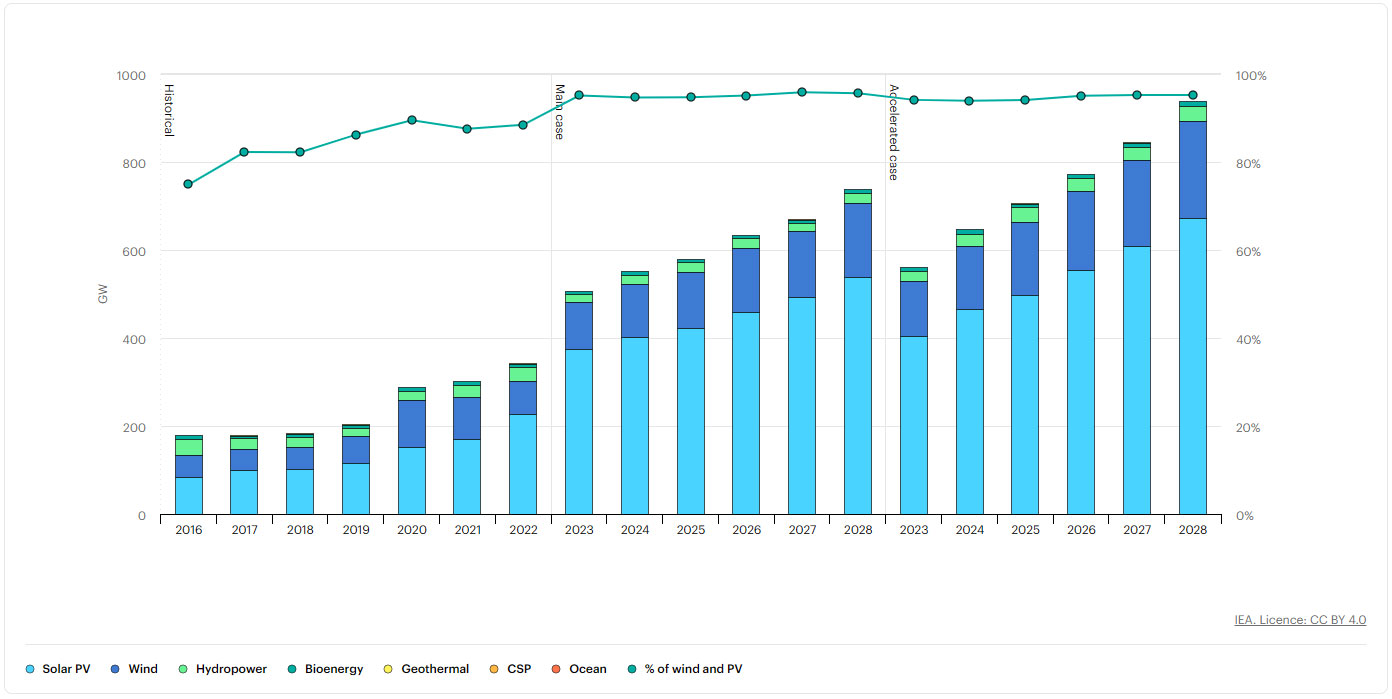
Source: Renewable electricity capacity additions by technology and segment
So, before selecting a software development partner, it’s crucial to understand the sector’s unique pain points that energy systems must address:
- Regulatory Complexity: Navigating a maze of incentives (ITC), policies (BABA), and compliance rules (FEOC) requires software with end-to-end audit trails and data integrity.
- Asset & Operational Scale: Software must manage vast portfolios of diverse assets (from individual wells and turbines to entire grid sections) balancing macro-level oversight with micro-level control.
- Integration of Legacy Systems: Many companies are shackled by outdated platforms that cannot communicate with modern IoT devices or cloud-based analytics tools, creating data silos and inefficiency.
- Demand for Real-Time Data: Field operations, finance, and leadership require synchronized, real-time data to make informed decisions on everything from maintenance schedules to energy trading.
The New Forces Reshaping the Energy Market
Besides the key issues energy companies need to deal with on a day-to-day basis, the global energy sector is now undergoing a seismic shift, driven by the dual forces of digital transformation and the transition to sustainable sources.
The shift is driven by three powerful, simultaneous forces:
- The Decarbonisation Mandate: Governments and corporations are committing to net-zero targets. Integrating intermittent, distributed sources into legacy grids now requires sophisticated software tools for forecasting, balancing, and dispatch optimization.
- Consumer and Prosumer Empowerment: The rise of prosumers — energy users who also produce power — has flipped traditional utility business models on their head. Platforms must now support bidirectional energy flows, peer-to-peer trading, and near-real-time data transparency for consumers and regulators alike. This shift fuels growth in software systems that manage DERs, grid flexibility, and customer engagement.
- Legacy Infrastructure and Aging Workforce: Much of the current energy infrastructure is decades old, and the skilled workforce is rapidly moving toward retirement. Operators now rely on digital platforms for predictive maintenance, asset-lifecycle management, and knowledge transfer — all of which demand specialised software solutions with built-in analytics and automation and trained personnel.
Read Also Clean, Green, Renewable: What U.S. Energy Companies Need to Know When Choosing Software
How to Choose Your Software Development Partner
Choosing a vendor is a strategic decision with long-term implications. Beyond technical skill, evaluate potential partners against these critical criteria:
Deep Industry Knowledge
A partner with proven experience in the energy sector understands regulations, market dynamics, and technical challenges specific to the domain. Their previous work in renewables, utilities, or smart grids should be verifiable through case studies and client references.
Strong Technical Proficiency
They must be skilled in IoT, cloud computing, AI/ML, and data analytics – technologies vital for innovative energy solutions. Familiarity with energy-specific standards and secure development practices is essential.
Scalability and Reliability
Choose a partner capable of building scalable architectures (cloud-native, microservices, or serverless) that handle large data volumes and user loads. Prioritize those with a track record of performance optimization and future-proofing systems.
Security and Compliance
Security cannot be compromised. Verify their compliance with energy sector security standards, including regular audits, vulnerability testing, and robust data protection protocols.
Effective Communication and Agile Process
The partner should maintain clear, transparent communication and involve stakeholders regularly. Agile methodologies with flexible, iterative development help to manage project risks and accommodate evolving requirements.
Innovation and Usability Focus
They should bring creative solutions and craft intuitive user experiences based on thorough user research and testing. Post-launch support and training are also critical for long-term success.
Top Energу Software Development Companies Through the COO Lens
The following analysis is based on the observations of the market, technical capability, specialized service offerings, and independent client reviews from platforms like GoodFirms or Clutch.
1. XB Software – Driving Digital Transformation in Energy and Beyond
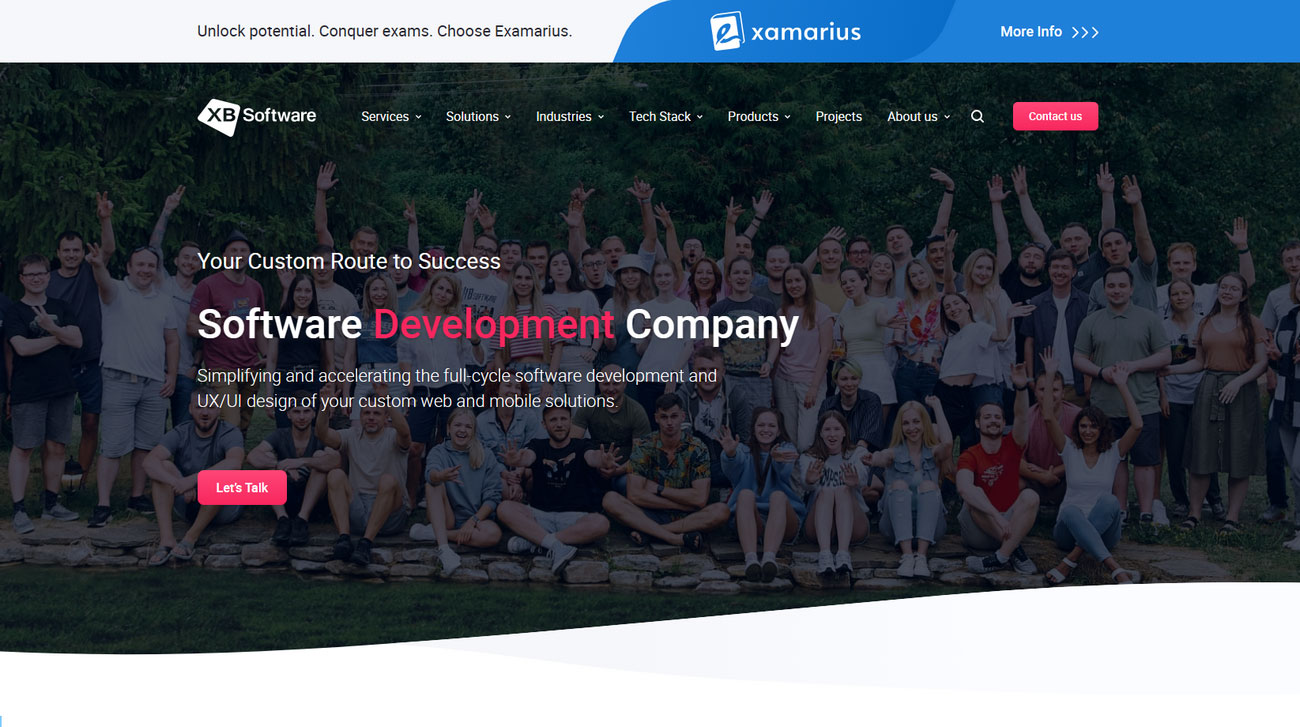
With more than 17 years in software development and over a decade focused specifically on energy technologies, XB Software has established itself as a reliable technology partner for utilities, oil and gas operators, and renewable energy companies. The company specializes in creating integrated software ecosystems that align with complex energy workflows and business objectives.
We focus on bridging the gap between strategic vision and operational execution in energy infrastructure. Our team architects digital foundations for successful projects, delivering custom management platforms and analytical tools built with React.js, Node.js, ElasticSearch, and our proprietary Webix and DHTMLX libraries. These solutions help to streamline complex operational workflows and transform raw data into actionable business intelligence.
The company’s portfolio includes collaborations with various energy sector participants to modernize legacy systems, consolidate fragmented workflows, and enhance data visualization capabilities. Our project experience spans custom Energy Management Systems (EMS), drilling operations management, field data collection systems, asset monitoring platforms, and renewable energy forecasting tools. Their methodology incorporates AI elements, project management frameworks, and advanced data visualization to create functional systems with measurable operational impact.
Core Services & Specializations: Custom EMS, Oil & Gas Project Management, Construction Management Systems for Renewable Energy, Legacy App Modernization.
Key Strengths:
- Deep Domain Expertise: 10+ years in energy-specific projects.
- Project Rescue Specialty: Proven track record of taking over and stabilizing failing projects.
- Full-Service Offering: End-to-end from business analysis to long-term support.
- Client Trust and Retention: High-quality solutions that attract clients and build long-term partnerships based on reliability and results — as reflected in our client reviews on GoodFirms.
2. SysGears
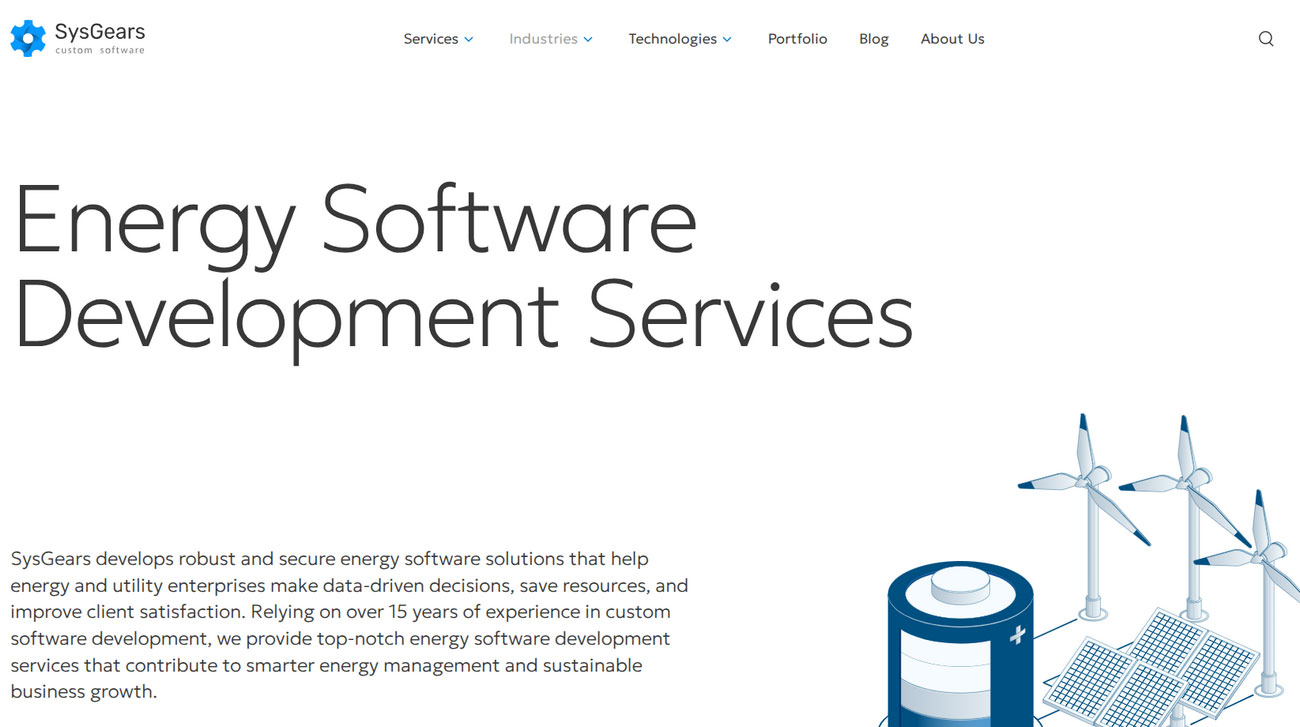
SysGears has made a name for itself as a team that knows how to design scalable, cloud-based software for the energy sector. Their focus on API-driven architecture, data analytics, and secure integrations makes them a strong choice for enterprises looking to modernize without compromising performance.
They seem to have a clear understanding of the operational realities in energy software. The fact that it’s not just about writing code, but about keeping systems running across dispersed assets, strict compliance environments, and evolving market structures makes the company a strong opponent.
In practical terms, this mindset matters when, say, a utility adds new service regions or a renewable operator expands into storage and smart grid projects. The software backbone must absorb those changes without causing operational friction, and that’s where such engineering discipline can serve well.
Core Services & Specializations: Cloud-Native Platforms, API-driven Architecture, Data Analytics & Secure Integrations.
Key Strengths:
- Scalable Engineering: Strong focus on building systems that can absorb business growth and change.
- Enterprise-Grade: Understands the need for performance in strict compliance environments.
3. Indeema

Indeema is one of the go-to names when it comes to IoT integration in energy software development. They specialize in connecting smart devices, sensors, and industrial equipment to centralized monitoring systems. Their experience spans oil and gas, renewables, and utilities, with a focus on predictive analytics, equipment maintenance, and energy efficiency.
From a COO’s standpoint, Indeema is able to bridge the gap between physical infrastructure and digital intelligence. It seems that they don’t just build interfaces for IoT devices but ensure those systems actually deliver operational visibility and preventive insights that keep energy assets productive and compliant. In practice, that means less downtime, more accurate forecasting, and a smoother flow of information between the field and headquarters.
Core Services & Specializations: IoT Integration, Predictive Maintenance, Sensor & Equipment Connectivity.
Key Strengths:
- IoT Specialization: Deep expertise in bridging physical assets and digital systems.
- Operational Visibility: Strong focus on delivering actionable insights to prevent downtime.
4. Enact Solar
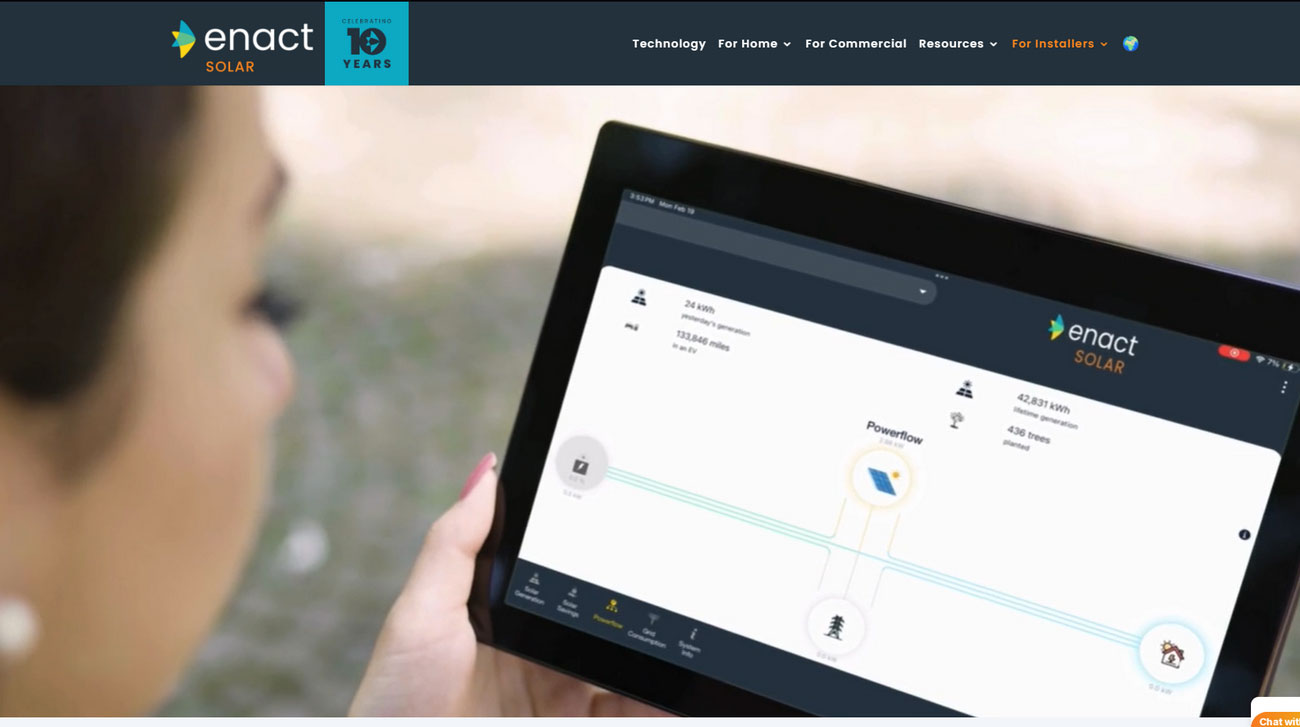
Enact Solar simplifies the solar project lifecycle through its cloud-based SaaS platform, helping both installers and end-users to manage design, installation, and performance monitoring efficiently. Their software combines advanced tools for pricing, contracts, and project management with intuitive dashboards that allow homeowners and businesses to track system health, energy production, and ROI.
From a COO’s perspective, what stands out is their end-user focus. They make complex solar data accessible and actionable for non-technical users. In practical terms, this means installers can scale operations more easily while customers gain transparency and confidence in their energy investments, reducing friction and increasing adoption of renewable solutions.
Core Services & Specializations: SaaS for Solar Project Lifecycle (Design, Installation, Performance Monitoring).
Key Strengths:
- End-User Focus: Excellent at making complex data accessible for homeowners and businesses.
- Streamlined Operations: Helps solar installers scale operations efficiently.
5. Mobio Solutions
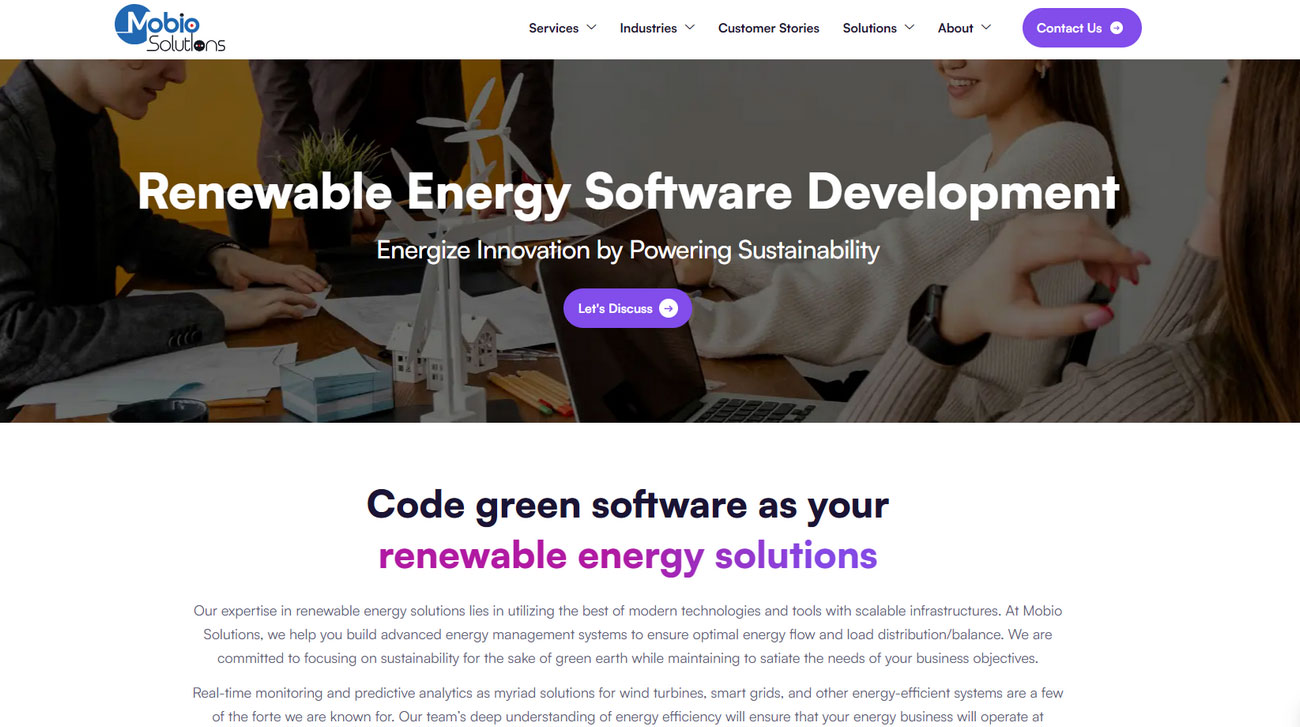
Mobio Solutions delivers mobile-first software for renewable energy operations, enabling field teams (technicians, inspectors, and engineers) to manage asset monitoring, data collection, and maintenance on the go. Their apps replace spreadsheets and paper workflows with intuitive digital tools that streamline inspections, reporting, and real-time updates.
They seem to focus on practical, field‑ready solutions that improve operational visibility and efficiency. In practical terms, this means faster decision-making, fewer errors, and a smoother connection between field operations and central management, accelerating the company’s overall digital transformation.
Core Services & Specializations: Mobile-First Field Operations, Asset Monitoring, Inspection & Data Collection Apps.
Key Strengths:
- Field-Centric Design: Replaces paper workflows with intuitive digital tools for technicians.
- Real-Time Sync: Enhances visibility and decision-making between field and office.
6. Trellis Energy
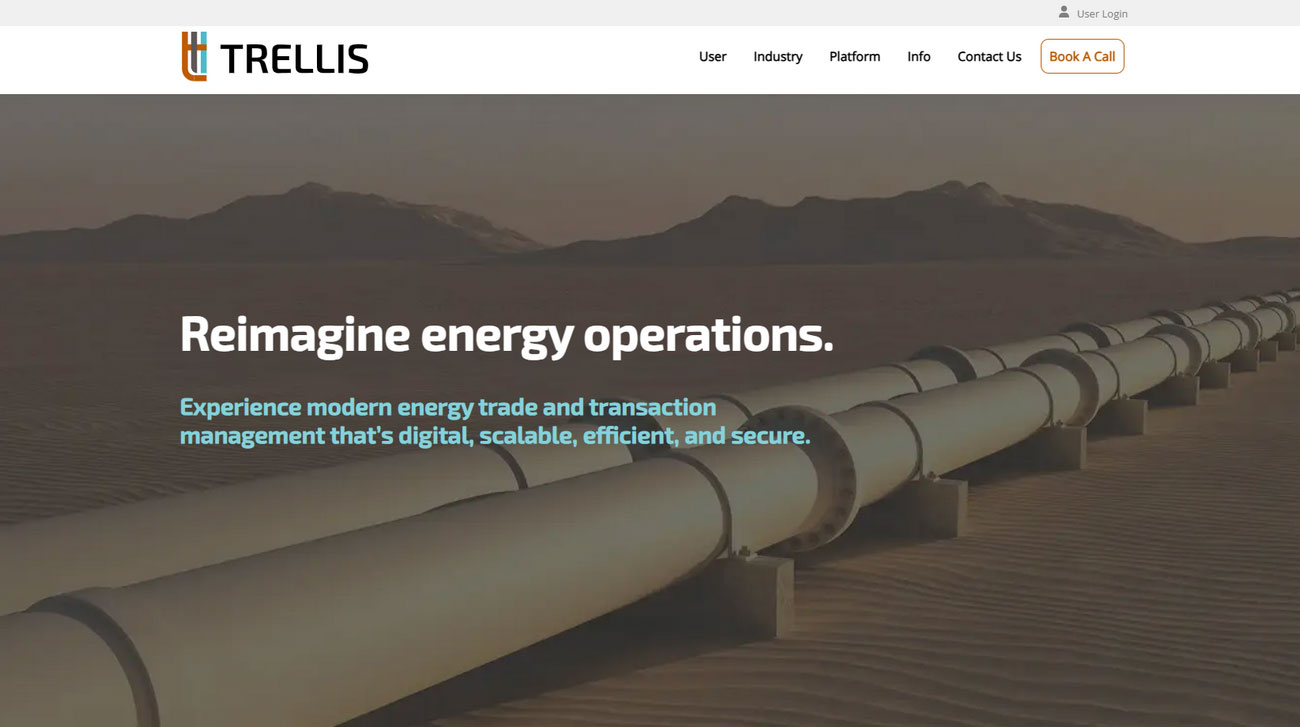
Trellis Energy offers a modular, cloud‑native platform designed to manage the full lifecycle of natural gas transactions, from nominations and scheduling to actualization and settlement, across the entire supply chain.
From a COO’s point of view, they seem to have a deep operational insight into compliance‑heavy environments: features like automated Electronic Data Interchange (EDI) integrations with pipelines, real‑time capacity tracking, and built-in support for standards, such as NAESB and FERC, ensure reliability and auditability.
Core Services & Specializations: Cloud-Native Platform for Natural Gas Transaction Lifecycle.
Key Strengths:
- Niche Compliance Expertise: Deep operational insight into highly regulated gas supply chains.
- Automation: Strong EDI integrations and capacity tracking.
Read Also ERP and EDI. What’s The Difference And How to Use Them Together
7. Exoft
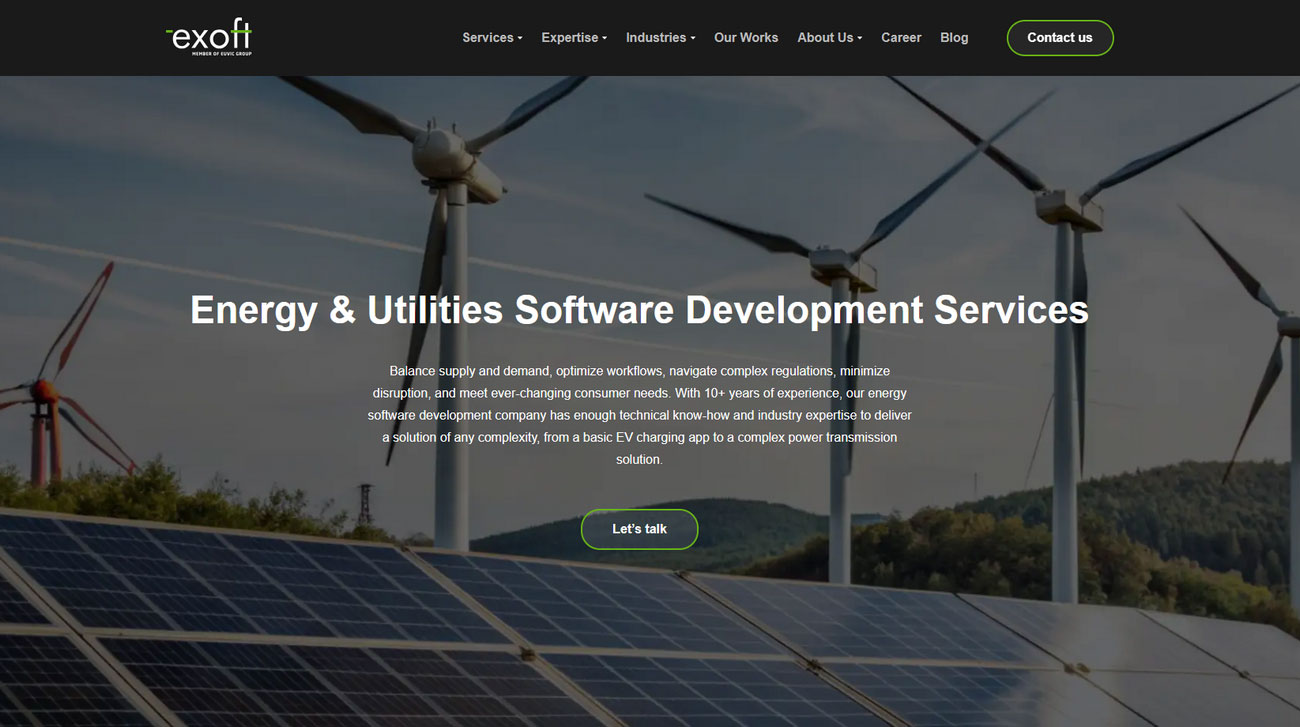
Exoft brings over a decade of industry experience to custom software development for the energy and utilities sector, delivering solutions ranging from EV‑charging apps and meter‑reading tools to complex smart grid platforms.
What stands out is their consulting‑first approach — prior to writing code, they help to define business goals, technical roadmaps, and regulatory requirements, ensuring that the software aligns with both operations and strategy. In practical terms, that translates to fewer surprises during rollout, better alignment with asset‑heavy workflows, and systems built to scale and integrate with legacy infrastructure.
Core Services & Specializations: EV-Charging Apps, Smart Grid Platforms, Meter-Reading Tools.
Key Strengths:
- Consulting-First Approach: Helps define business goals and roadmaps before development.
- Legacy Integration: Experience building systems that work with existing infrastructure.
8. Albiorix

Albiorix Technology delivers custom energy management solutions (from smart grid systems and EV‑charging apps to meter‑reading portals) designed to reduce complexity and boost operational insight.
What distinguishes them is their dual mastery of tech and user‑experience: they build modern, web‑based interfaces for heavy-duty systems so that even non‑technical users can navigate asset dashboards and analytics easily. In practice, this means fewer training headaches, faster adoption across teams, and smoother digital transition when moving from legacy systems to responsive platforms.
Core Services & Specializations: Smart Grid Systems, EV-Charging Apps, Meter-Reading Portals.
Key Strengths:
- User-Experience Focus: Excels at building modern, intuitive interfaces for complex, data-heavy systems.
- Reduced Complexity: Aims to make systems easy for non-technical users to adopt.
9. Brightly Software

Brightly’s cloud‑based platform, Energy Manager, gives facility and energy managers a unified dashboard to track utility consumption, carbon emissions, and cost‑saving initiatives across portfolios. Their strength is in the deep integration with Siemens’ industrial ecosystem, enabling seamless connectivity with building management systems, infrastructure networks and sustainability workflows.
From a COO’s point of view, this means fewer data silos, stronger compliance, and faster, informed decision‑making on energy strategy — translating directly into measurable cost and carbon reductions.
Core Services & Specializations: Energy & Sustainability Management (Carbon Emissions, Utility Tracking).
Key Strengths:
- Siemens Ecosystem Integration: Seamless connectivity with building management and industrial systems.
- Portfolio-Level Insight: Strong for tracking sustainability KPIs and cost-saving initiatives across multiple facilities.
Read Also Why Off-the-Shelf SaaS Doesn’t Work for Oil & Energy Projects — And What to Do Instead
Why XB Software Often Becomes the Right Choice
I’ll be candid: we don’t claim to be the cheapest or the biggest among custom software development companies. We claim to be relentlessly practical. That mindset, honed over hundreds of projects, manifests in three tangible ways that directly address the core concerns of energy operators:
- We de-risk your investment through proven leadership and processes. Our “project rescue” specialty, guided by PMP-certified management, provides a disciplined approach to salvaging stalled projects. We stabilize chaotic codebases, establish clear governance, and refocus on delivering tangible business value, ensuring your software investment finds a clear path to success without starting from scratch.
- We accelerate development with proprietary technology. Our ownership of the DHTMLX UI components and Webix JavaScript UI library gives us a distinct advantage. We leverage these enterprise-grade toolkits to rapidly build complex, data-heavy interfaces that are performant and reliable from day one, translating directly into faster delivery and a superior user experience.
- We align price with value, not just hours. Moving beyond simple T&M vs. Fixed Price, our Budget with Float Scope (BFS) model offers flexibility to adapt to changing needs without budget overruns. Combined with value-based prioritization, we ensure we build high-impact features first, reducing financial surprises and maximizing your operational ROI.
- We build with your tomorrow in mind. We architect for future challenges. Our focus on modular, scalable design and proven expertise in modernizing legacy software ensure the platform you get can absorb new business lines, regulations, and technologies without a costly overhaul. We build software that evolves as a strategic asset, not one that decays into a legacy anchor.
The Future of Digital Transformation in Energy
The energy sector is at a turning point. AI, machine learning, and IoT are reshaping how we generate, distribute, and consume energy. The companies that embrace digital transformation today — not as a buzzword, but as a core business strategy — will define the next decade of innovation.
If you’re searching for an energy software development partner in the USA, don’t settle for generic. As someone who’s seen countless digital projects evolve, the advice to COOs and CTOs in the energy sector is to:
- Choose a software partner who understands your industry’s complexity,
- Look for flexibility, not just features,
- And always think in terms of long-term scalability, not short-term fixes.
While many firms can build, few can do it in a way that anticipates market shifts, policy changes, and regulatory demands. We at XB Software aim to do just that, because building for tomorrow is the only sustainable business. So, if you are looking for the best fit, contact us, and share the details of your software or a project idea so that we develop a system that works for you and your business, not against you.